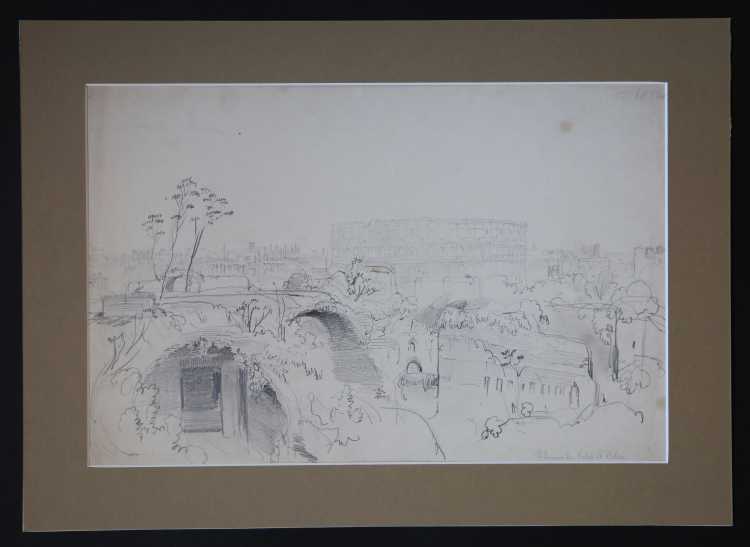




| Reference: | S36360 |
| Author | Felix BENOIST |
| Year: | 1864 ca. |
| Zone: | Terme di Tito, Colosseo |
| Measures: | 450 x 298 mm |



| Reference: | S36360 |
| Author | Felix BENOIST |
| Year: | 1864 ca. |
| Zone: | Terme di Tito, Colosseo |
| Measures: | 450 x 298 mm |
Black pencil drawing, mm 450x300, datable to ca. 1864. The lower right-hand corner bears the handwritten annotation Thermes de Titus et Colisée.
Belongs to a collection of 127 works unearthed from a French antiquarian who, in turn, had acquired them from the heirs of publisher Henri-Désiré Charpentier (La Rochelle 1805 - Vertou 1882); they are all done in black pencil, some have white lead highlighting; they never bear the date and signature of the author, but only a brief caption relating to the subjects depicted. The drawings denote a skilled and expert hand - especially in the delineation of buildings, ruins and architecture - that restores the monuments of Rome from interesting and unusual perspective points. The reference of most of the drawings to some of the tinted lithographs by Felix and Philippe Benoist, published in the three-volume work Rome dans sa grandeur, immediately became clear. The fact that this is a large group of original drawings related to the famous work edited by Henri-Désiré Charpentier is clearly supported by the prestigious provenance; it is a part of Charpentier's heir fund, among which the material of the famous chalcographic workshop had been divided.
Rome dans sa grandeur. Vues, monument ancient et modernes was printed in Paris in 3 volumes, in 1870. The publication, illustrated by 100 lithographs, was preceded by a campaign of preparatory drawings, dating from 1864 until 1869, executed mainly by Félix Benoist and partly by Philippe Benoist. On the eve of the Concilio Ecumenico Vaticano I, on August 11, 1869, Pius IX decreed the creation of a Roman Exhibition of the works of every art executed for Catholic worship, which was inaugurated, on February 17, 1870, in the cloister of the Carthusian monastery of Santa Maria degli Angeli. On that occasion, the three folio volumes Rome dans sa grandeur were presented. The lavishly bound volumes, with the coat of arms of Pius IX stamped in the center in gold, are divided into three sections. The first volume deals with ancient Rome, the second, with Christian Rome, and the third, with the monuments and achievements of modern Rome. A valuable view of papal Rome on the eve of Rome's profound transformation into the capital of united Italy. A document that highlights the remarkable imprint left by Pius IX on the Eternal City. The work represents the French artist's masterpiece, so much so that it places Benoist among the ranks of the greatest artists of interiors and views of his time.
The sheets used for the preliminary studies vary in size (from 170 mm x 240 to 490 x 300 mm), weight and even color gradation (from beige to green). Many of the drawings undeniably represent different preparatory stages - more or less complete - of some of the dyed lithographs illustrating the magnificent work, others of the silographic vignettes included in the text, while other sketches do not find translation in print. Belonging to this second group are both sketches relating to monuments and views of Rome and its surroundings: ancient Ostia, Grottaferrata, Olevano Romano, Anzio, Nettuno, Velletri and Vicovaro. Far beyond from Rome are drawings relating to Naples and Loreto. The suite was to form part of the entire fund, later dispersed, of preparatory studies from which the hundred intended for lithographic printing were selected.
This splendid drawing, which looks at the Colosseum through a portico of the site of the Baths of Titus, does not find a corresponding lithograph in Rome dans sa Grandeur but corresponds exactly to the description that is given of the site of the Baths in Volume I - Rome Ancienne (chap. I, p. 43): “Les Thermes de Titus n' existent réellement plus; mais la villa de Néron, sur laquelle ils avaient été construits, nous présente encore une trentaine de chambres et plusieurs corridors. C'est là que se trouvent ces arabesques si élégantes de dessin et si vives de couleur, qui faisaient l'admiration de Raphaël”.
The perspective is from the site of the Baths of Titus. Built by Titus and dedicated in 80 AD, these baths occupied the area north-east of the Colosseum, in the III region immediately next to the Domus Aurea, on which, perhaps, they were partly superimposed. A characteristic of Flavian policy was, in fact, that of returning the spaces previously occupied by Nero to public use. The complex was known to us until today mainly thanks to the drawings drawn up by Andrea Palladio at the end of the 16th century; it occupied the southern slopes of the Oppio hill and therefore had to include an access staircase that led from the Colosseum to the thermal environments; these seem to be composed of a central body, not large in size, around which other rooms were arranged.
|
Félix Benoist was a skilful and composed litographer and one of the most renewed French artists of landscapes in the 19th century. He printed many works together with Philippe Benoist, painter and lithographer born in Geneva in 1813, among which are: “Rome dans sa grandeur” a beautiful and thorough work on Papal Rome.
|
|
Félix Benoist was a skilful and composed litographer and one of the most renewed French artists of landscapes in the 19th century. He printed many works together with Philippe Benoist, painter and lithographer born in Geneva in 1813, among which are: “Rome dans sa grandeur” a beautiful and thorough work on Papal Rome.
|